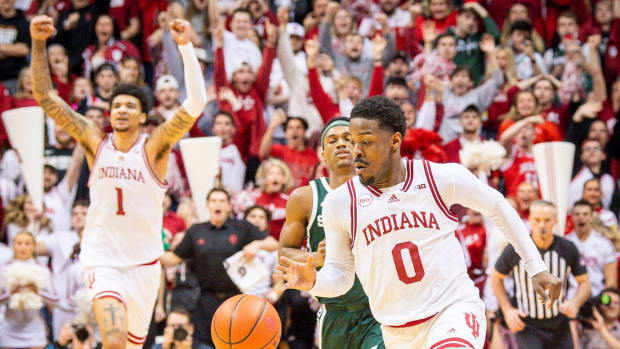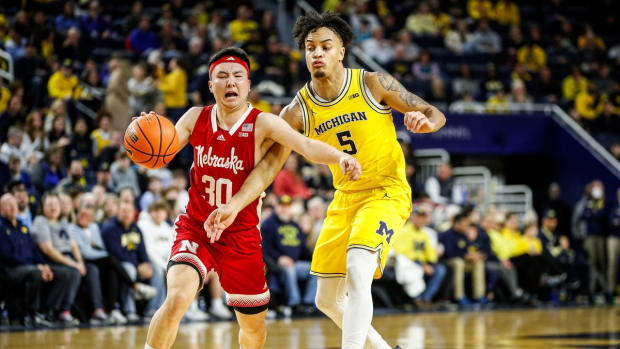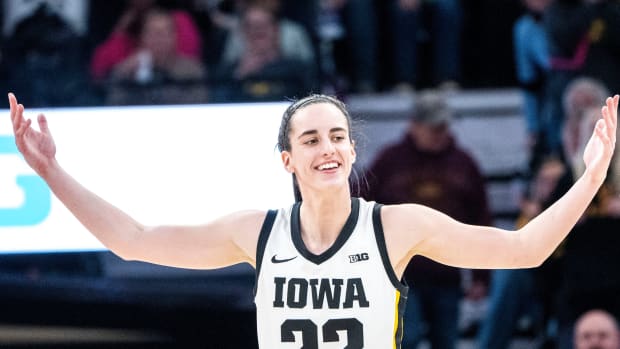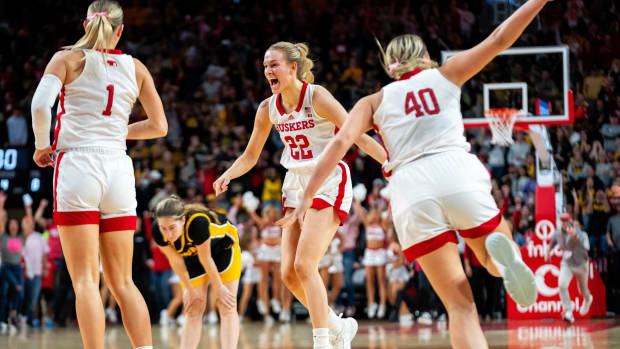Michigan Basketball: Week 1 Statistical Deep Dive
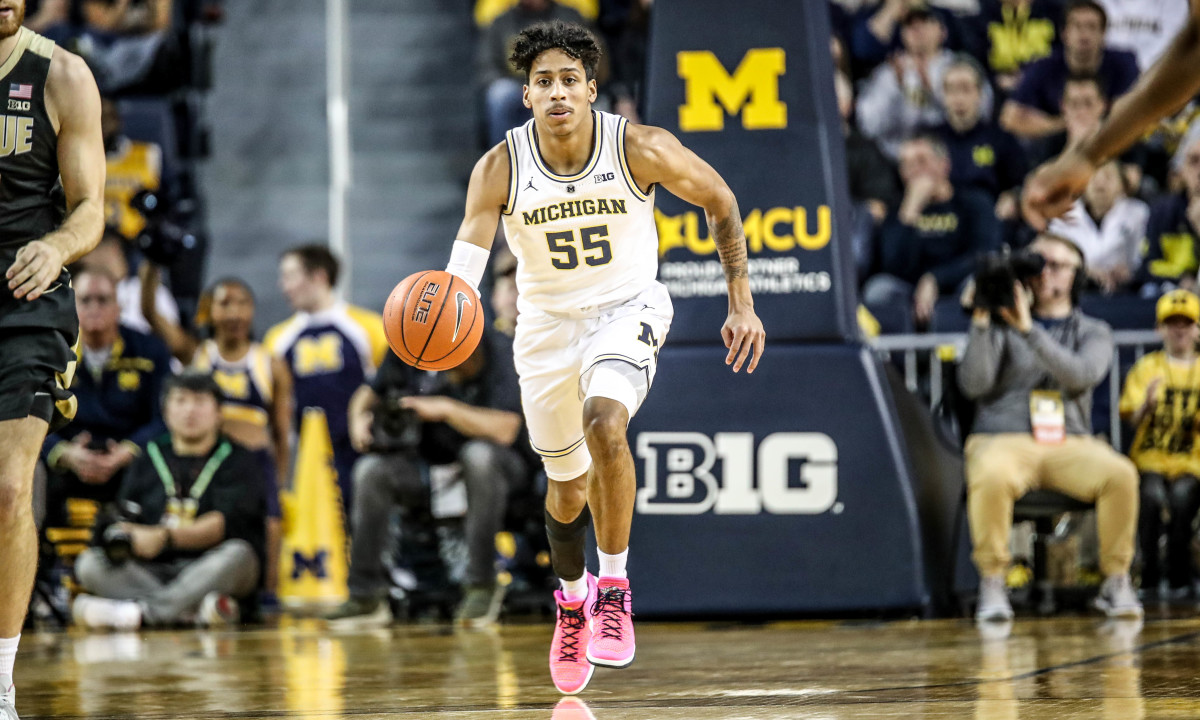
There were players adjusting to enhanced roles and increased floor-time, alarming statistical shortfalls that U-M hoops fans hope are nothing more than one-game anomalies, and season-wide trends from a year ago that picked up right where they left off.
Here is a look at notable player-specific trends and advanced stats from the first week of the season using the KenPom statistical model. If you are unfamiliar with KenPom and its metrics, you can read last week’s primer here.
*To qualify for individual conference rankings, players must log between 40 percent and 60 percent of possible minutes played, depending on the metric.
Key Trends
• Michigan would have been in a world of trouble without the emergence of junior guard Eli Brooks, who scored 38.0 percent of the Wolverines’ points against Appalachian State, including 48.5 percent of U-M’s second-half scoring.
• Michigan’s long stretch of offensive inadequacy in the second half - U-M was outscored 30-5 during a 12-minute run - can be, in part, attributed to the uncharacteristic struggles of junior forward Isaiah Livers and senior point guard Zavier Simpson. Both players, who the Wolverines will lean on heavily this year, logged a Percentage of Possessions Used (%Poss) of 22.0 or more and responded with sub-90 Offensive Ratings (ORtg).
The two currently rank 91st and 92nd out of 92 qualified Big Ten players with Turnover Rates (TORate) of over 37, which is more than 11 points worse than the conference’s most careless ball handler from a year ago—Jamari Wheeler of Penn State, who stumbled to a 25.8 TORate.
A year ago, both rated above average for their respective positions in TORate, which should offer hope that this spell of poor ball security is a one-game aberration rather than cause for serious concern.
• Four Wolverines registered Effective Field Goal Percentage (eFG%) of 60.0 or more. In 2018-19 Livers was the only player with at least 12%Poss to boast an eFG% above 60.0 at 61.8.
• Last season, Teske had the second-best ORtg on the team (120.1) but just the fifth-highest %Poss (17.0), a trend that continued to start this year. Teske led Michigan with a 130.4 ORtg against the Mountaineers, but his 19.9%Poss was good for just fifth-best on the squad.
• Only three Wolverines earned a Defensive Rebound Percentage (DR%) considered good by KenPom’s metrics, with Teske’s 36.3 leading the way, and his 13.9 Offensive Rebound Percentage (OR%) made him the only U-M player that scored above average in the metric.
• Head coach Juwan Howard utilized an eight-man rotation against ASU, with only six playing at least 50%Min. The minute distribution would almost certainly have been even more top-heavy had Livers and Simpson not sat for extended periods of time because of foul trouble.
Most Frequent Lineup Combinations (through one game):
1. Simpson, DeJulius, Brooks, Livers, Teske — 33.6%
2. Simpson, Brooks, Nunez, Livers, Teske — 12.1%
3. Brooks, DeJulius, Livers, Castleton, Teske — 10.2%
4. Simpson, DeJulius, Brooks, Johns, Teske — 9.4%
5. Brooks, DeJulius, Livers, Johns, Castleton — 9.1%
Starting Five
Point Guard: Senior Zavier Simpson
Traditional Stat Line: 6.0 points, 6.0 assists, 8.0 rebounds, 6.0 turnovers, 3.0 steals, 0.0 blocks
Usage: Despite early foul trouble, Simpson played in 70 percent of available minutes and recorded a 28.3%Poss rating—a stark increase from his 19.3%Poss last season. Unfortunately, his %Poss was elevated by six possessions ending due to a turnover he committed (more on that later). He was just one of 11 conference players with at least a 28%Poss during the first week of the season.
ORtg: Simpson’s ORtg against Appalachian State was an abysmal 67.8, which ranks 89th out of 92 qualified league players.
Four Factors: The senior’s 27.6 DR% is considered a good percentage for a point guard but his 25.0 eFG%, 39.2 TORate and 37.5 Free Throw Rate (FTRate) are all deemed to be below average by KenPom standards. In fact, his 39.2 TORate after the first week of the season was the worst among all 92 qualifying Big Ten competitors, and a 20.8 increase from last season (18.8).
Other Stats: Simpson sits in the top-10 in the league in Steal Percentage (Stl%) at 5.55 (5th Big Ten) and Assist Rate (ARate) at 32.8 (10th Big Ten). During the 2018-19 season, he was sixth in Stl% (2.59) and second in ARate (36.4).
Shooting Guard: Junior Eli Brooks
Traditional Stat Line: 24.0 points, 3.0 assists, 2.0 rebounds, 2.0 turnovers, 3.0 steals, 1.0 blocks
Usage: Brooks paced the Big Ten in logging 92.5 percent of possible minutes played and led the Wolverines with a 22.3%Poss, both massive increases from a year ago (32.2%Min, 13.4%Poss).
Offensive Rating (ORtg): The junior guard responded to his increased role with a sterling 129.8 ORtg, good for second best in the Big Ten among players that registered a %Poss of at least 20.0.
Four Factors: Brooks graded outstanding in eFG% (63.3, 11th Big Ten), above average in TORate (12.3, 33rd Big Ten), and his 40.0 FTRate placed him at No. 24 among all qualifying conference players after the first week of the season.
Other Stats: Although he was relied upon heavily to score for an offense that was often stuck in quicksand during the second half, Brooks’ 15.1 ARate was good for second-highest on the team, and an exact match to his 15.1 ARate over the entirety of the 2018-19 season.
Small Forward: Sophomore Adrien Nunez
Traditional Stat Line: 5.0 points, 0.0 assists, 0.0 rebounds, 1.0 turnovers, 0.0 steals, 0.0 blocks
Usage: Although inserted into the starting lineup, Nunez’s time on the floor was limited to only 32.5 percent of available minutes and his 12.1%Poss was the second lowest on the team. Still, his floor-time was much increased from a year ago, when he saw a team-low 2.7%Min.
Offensive Rating (ORtg): Nunez was efficient when called upon with an above-average 111.9 ORtg, a vast improvement from his team-worst 30.3 ORtg as a freshman.
Four Factors: Nunez made the most of his few shooting opportunities with a team-best 83.3 eFG% (DNQ Big Ten). He did not snag any rebounds or attempt a free throw, and his 33.0 TORate was well below average.
Other Stats: The sophomore has not yet recorded an assist, steal or block.
Power Forward: Junior Isaiah Livers:
Traditional Stat Line: 14.0 points, 1.0 assists, 2.0 rebounds, 5.0 turnovers, 1.0 steals, 0.0 blocks
Usage: Livers played the entirety of the first half, but sat for long stretches in the second because of foul trouble. In total, he appeared in 77.5 percent of available minutes and finished with a 22.4%Poss..
Offensive Rating (ORtg): One of only three Wolverines to log an Offensive Rating under 100, Livers 87.2 ORtg put him at No. 31 out of 40 Big Ten players with at least a 20%Poss. Last season, his 120.8 ORtg was the Wolverines’ best.
Four Factors: Livers’ enjoyed a very efficient 63.3 eFG% (9th Big Ten), but his OR% (3.6), DR% (4.2) and FTRate (0.0) were well below average for a forward. His uncharacteristic 37.3 TORate was second-worst out of 92 qualified league players after one week of play, and exactly 26 points higher than his 2018-19 average (11.3).
Other Stats: Livers 6.1 ARate and 1.7 Stl% were both essentially on par with what he produced last season (6.2, 1.9). His 0.0 Block Percentage (Blk%) was well below his output in the stat from a year ago (2.5, 2nd on team), although the combination of ball denial and lack of aggressiveness by the players he was tasked with guarding resulted in very few block opportunities.
Center: Senior Jon Teske:
Traditional Stat Line: 17.0 points, 1.0 assists, 13.0 rebounds, 1.0 turnovers, 0.0 steals, 3.0 blocks
Usage: Teske sits third among all conference big men in playing at 80%Min, but his 19.9%Poss was only the fifth-most on the team.
Offensive Rating (ORtg): Teske’s eye-popping 130.4 ORtg led all Wolverines and was a 10.3-point increase from a year ago (120.1).
Four Factors: Teske’s aggregate production and efficiency was unmatched among U-M contributors, ranking in the top-20 in the league in all Four Factors: eFG% (62.5, 11th Big Ten), OR% (13.9, 7th Big Ten), DR% (36.3, 2nd Big Ten) and TORate (8.1, 16th Big Ten). This is a trend is a continuation from a year ago, where he led all significant Michigan contributors (at least 40%Min) in OR% (8.4), DR% (20.2) and TORate (6.3), and finished second in eFG% (56.5).
Other Stats:
Teske’s 8.5 Blk% is up more than one point from last season (7.4) and good for 8th in the conference.
Off The Bench
Sophomore Guard David DeJulius:
Traditional Stat Line: 0.0 points, 3.0 assists, 2.0 rebounds, 0.0 turnovers, 1.0 steals, 0.0 blocks
Usage: The first man off the bench, DeJulius played in 70 percent of available minutes. Although his %Min was tied for third-most on the team, his %Poss was the lowest among all Wolverines that saw action at 7.0.
Offensive Rating (ORtg): The sophomore was held scoreless in 28 minutes of action and recorded a team-low 48.9 ORtg.
Four Factors: DeJulius missed all three of his field goal attempts, resulting in a 0.0 eFG%,did not grab an offensive rebound and, although his FTRate of 66.7 is considered well above average by KenPom standards, he missed both of his free throw attempts. He did register a 9.7 DR%, which was second-best among Michigan guards, and didn’t turn the ball over (0.0 TORate) which was critical for a U-M squad that struggled with ball security all evening.
Other Stats: DeJulius finished with a respectable 14.8 ARate, more than 5 points better than his 2018-19 season total (9.1).
Sophomore Forward Brandon Johns Jr.:
Traditional Stat Line: 5.0 points, 1.0 assists, 3.0 rebounds, 1.0 turnovers, 1.0 steals, 2.0 blocks
Usage: Johns saw action in 47.5 percent of available minutes, a nearly 40-percent increase from a year ago (7.9%Min) and his 17.3%Poss was five-percent higher than his 2018-19 usage (12.3%Poss).
Offensive Rating (ORtg): The sophomore big man boasted a respectable 100.8 ORtg, he finished with a 102.8 ORtg last season in a much smaller role.
Four Factors: Johns 50.0 eFG% is considered good and his 75.0 FTRate excellent by KenPom standards. Both his 17.5 OR% and 15.7 TORate measure close to average, but he did not grab any defensive rebounds.
Other Stats: Johns ranks top-20 in the conference in Blk% (9.57, 7th Big Ten) and Stl% (2.73, 20th Big Ten).
Sophomore Center Colin Castleton:
Traditional Stat Line: 8.0 points, 0.0 assists, 2.0 rebounds, 1.0 turnovers, 1.0 steals, 0.0 blocks
Usage: Caslteon only saw action in 30.0 percent of possible minutes, but was aggressive in his limited role with a 24.4%Poss — the second highest on the team.
Offensive Rating (ORtg): The sophomore big man was U-M’s most efficient offensive player off the bench with a 119.2 ORtg, almost 30-points better than his 80.5 ORtg last season.
Four Factors: Castleton’s 60.0 eFG% is considered well above average in KenPom’s ratings system, but he graded slightly below average in OR% (9.3), DR% (10.3), TORate (17.7) and FTRate (40.0).
Other Stats: Castleton’s 4.3 Stl% was the second-best on the team, and he did record an assist or block.
Did Not Play
Junior Guard C.J. Baird, Freshman Guard Cole Bajema, Senior Forward Austin Davis, Junior Forward Jaron Faulds, Junior Guard Rico Ozuna-Harrison, Freshman Guard Franz Wagner (due to injury), Junior Guard Luke Wilson

